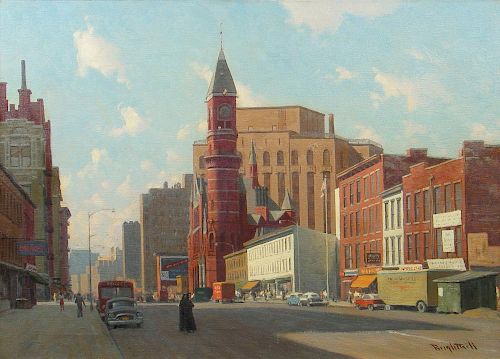Walter Brightwell, Looking Down 6th Avenue Toward the Jefferson Market Building Oil Painting
Lot 101
About Seller
Arader Galleries
1308 Walnut Street
King of Prussia, PA 19406
United States
Arader Galleries proudly celebrates over 40 years in the business of important, antique works on paper, paintings and rare books. W. Graham Arader III began his collection of rare maps, atlases and Americana while an undergraduate at Yale University, and today that passion has grown into one of the ...Read more
Categories
Estimate:
$6,000 - $8,000
Absentee vs Live bid
Two ways to bid:
- Leave a max absentee bid and the platform will bid on your behalf up to your maximum bid during the live auction.
- Bid live during the auction and your bids will be submitted real-time to the auctioneer.
Bid Increments
| Price | Bid Increment |
|---|---|
| $0 | $25 |
| $500 | $50 |
| $1,000 | $100 |
| $2,000 | $250 |
| $5,000 | $500 |
| $10,000 | $1,000 |
| $20,000 | $2,000 |
| $50,000 | $5,000 |
| $100,000 | $10,000 |
| $200,000 | $25,000 |
About Auction
By Arader Galleries
Jan 28, 2017 - Jan 29, 2017
Set Reminder
2017-01-28 13:00:00
2017-01-29 13:00:00
America/New_York
Bidsquare
Bidsquare : Arader Galleries Winter 2017 Auction
https://www.bidsquare.com/auctions/arader/arader-galleries-winter-2017-auction-2063
Arader Galleries loricohen@aradergalleries.com
Arader Galleries loricohen@aradergalleries.com
- Lot Description
Looking Down 6th Avenue Toward the Jefferson Market Library Building. Walter Brightwell (b. 1919- after 1971). Oil on board, c. 1939. Signed lower right: 'Brightwell". 20 x 28 inches. The Jefferson Market Library building and surrounding area are a terrific example of the evolution of New York City over the span of a century. In the 1830s Jefferson Market, located on Sixth Avenue between West 9th and 10th Streets, existed as a major food market, distinguished by its wooden lookout tower used to spot fires. In the 1870s a Victorian courthouse was erected on the site of Jefferson Market. It was hailed as one of the most beautiful buildings in America and transformed the landscape, becoming a local landmark. The wooden tower was reinforced with red brick and featured a new clock, retaining the original bell. The building continued to serve the West Village as a lively courthouse until the late 1940s, when it was left vacant and fell under the threat of condemnation. Village community members, including E. E. Cummings, rallied to save the building, and in 1967 it reopened as a public library. Meanwhile, the area around the Jefferson Market had developed a great deal as well. The Sixth Avenue “El” train opened in 1878, towering above the street. It was soon an attraction to artists such as the Ashcan School painters and Edward Hopper, who depicted candid images of everyday city life. When the underground IND Sixth Avenue Line (now the B and D subway lines) opened in the late 1930s, the El was dismantled. The absence of the train, which had been a strong visual presence on Sixth Avenue, as well as a source of noise and dirt, transformed the streetscape. This painting by Brightwell was completed shortly after the removal of the El. It is a view looking south from the southeast corner of 12th Street and Sixth Avenue on a sunny New York morning. Since only a few cars, trucks, and people populate the street, one gets a strong feeling of the avenue’s openness, which must have been especially striking soon after the removal of the El. The painting is a discourse on the constant development of the city, juxtaposing old and new. The Jefferson Market Courthouse, a Victorian structure, rises before a modern industrial building, and turn-of-the-century row houses in the foreground give way to apartment houses in the distance. In the extreme foreground, Brightwell’s inclusion of a construction site implies further growth and change. Traffic and shops demonstrate continued commerce; the area remains a shopping district a full century after the area’s original birth as a food market. Walter Brightwell studied with Frank DuMond, and kept studios in Maine, New York City, and Florida. He was a member of the American Watercolor Society, Allied Artists of America, Academic Artists Association, the Florida Watercolor Society, and the Navy Combat Artists. His work has been shown in numerous juried exhibitions, including a one-man show at the Elliott Museum of Stuart, Florida. Works by Brightwell have also been exhibited at institutions such as the Museum Marine, Paris; Allied Artists of America, New York; National Academy of Design, New York; Fort Lauderdale Museum of Arts, Florida; and at Grand Central Art Galleries, New York. His paintings are included in the permanent collection of the US Navy Combat Art Collection, Washington, D. C. Brightwell was commissioned to paint a mural at West Side Savings Bank, New York, and has also been the recipient of various awards, including the George Burr Gold Medal of the National Arts Club.
- Shipping Info
-
Shipping Terms:Packing and handling of purchased lots by us or by someone else is at the entire risk of the purchaser. Purchasers are responsible for all packing and shipping costs.
We are not responsible for the acts or omissions of carriers or packers of purchased lots whether or not recommended by us.
-
- Buyer's Premium



 EUR
EUR CAD
CAD AUD
AUD GBP
GBP MXN
MXN HKD
HKD CNY
CNY MYR
MYR SEK
SEK SGD
SGD CHF
CHF THB
THB




